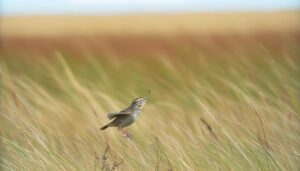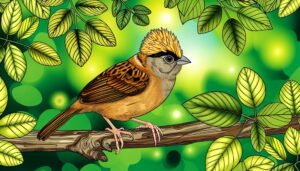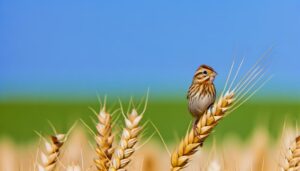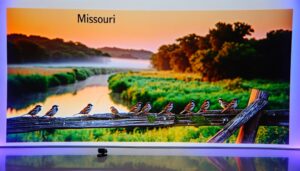5 Common Sparrows to Spot in Minnesota
Minnesota boasts a diverse variety of sparrows. Common species include the American Tree Sparrow, identified by its rusty cap and gray underparts, and the Chipping Sparrow, recognized by its rust-colored cap, white eyebrow, and black eyeline.
The Field Sparrow sports a pink bill and rufous wings, while the House Sparrow is noticeable with its gray head in males and buff eyeline in females. The presence of the White-throated Sparrow is marked by its yellow lores and striped head.
These species exhibit unique behaviors and adaptability to various environments, details of which offer intriguing insights into their contributions to the ecosystem.
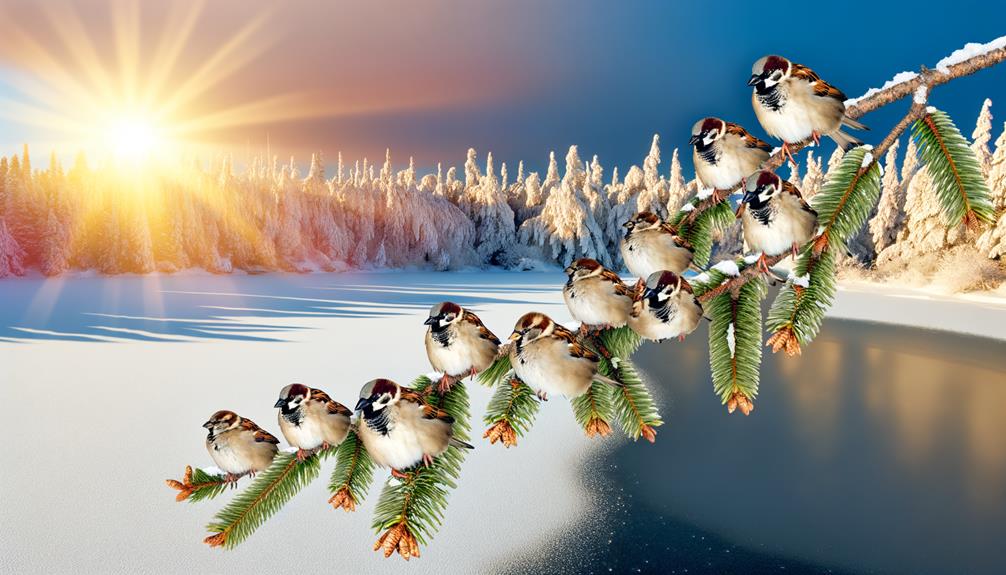
Key Takeaways
- Minnesota is home to several species of sparrows, including the American Tree, Chipping, Field, House, and White-throated Sparrows.
- The American Tree Sparrow can be identified by its rusty cap and eyeline, and gray underparts.
- The Chipping Sparrow is recognized by its rusty cap, white eyebrow, and black eyeline.
- The Field Sparrow has a pink bill, eyering, and rufous wings and tail, while the House Sparrow has a gray head in males and a buff eyeline in females.
- The White-throated Sparrow is characterized by its white throat, yellow lores, and striped head.
Understanding Sparrow Basics
In order to fully appreciate the diversity of sparrows in Minnesota, understanding the basic characteristics that define these small, often overlooked birds is essential.
Sparrows, belonging to the family Passeridae, are characterized by their small size, stout bodies, rounded heads, short tails, and conical beaks. Their plumage, often muted in shades of brown, gray, and white, enables effective camouflage in their environments.
They're primarily granivorous, with seeds and grains forming the bulk of their diet, although they'll consume invertebrates, particularly during breeding season. They exhibit a high degree of sexual dimorphism, with males typically more brightly colored than females.
Their songs are distinctive, composed of a series of chirps and trills, conveying information about territory and mating status.
Habitat and Distribution
Sparrows, despite their small size, have a wide distribution across Minnesota, occupying a diverse range of habitats from dense forests to urban gardens.
- Dense Forests: They're adept at maneuvering through thick undergrowth and find plenty of insects for sustenance here.
- Urban Gardens: Sparrows have adapted to human settlements, often nesting in garden hedges and finding food in bird feeders or discarded scraps.
- Grassy Fields: Open fields provide sparrows with seeds, their primary food source, and tall grasses offer cover from predators.
- Marshlands: Minnesota's marshlands, particularly in the north, attract species like the Swamp Sparrow that prefer wetlands.
This broad adaptability explains their ubiquitous presence and assures their survival, despite environmental changes.
Each habitat fulfills specific needs, shaping the sparrows' behaviors and adaptations.
Minnesota Sparrow Identification
Recognizing different species of sparrows in Minnesota requires a keen eye and a basic understanding of their distinguishing characteristics. The state is home to numerous species, all varying slightly in appearance and behavior.
Here's a brief identification guide for five common species:
| Species | Key Identification Features |
|---|---|
| American Tree Sparrow | Rusty cap and eyeline, gray underparts |
| Chipping Sparrow | Rusty cap, white eyebrow, black eyeline |
| Field Sparrow | Pink bill, eyering, rufous wings and tail |
| House Sparrow | Gray head (male), buff eyeline (female), stout bill |
| White-throated Sparrow | White throat, yellow lores, striped head |
Sparrow Anatomy and Appearance
While identifying different species, it's clear that each sparrow's anatomy and appearance play an important role. Sparrows, though small, have distinct characteristics that make them unique.
Size and Shape: Sparrows are compact birds with short tails and stubby, powerful beaks. They typically measure between 4.5 to 7 inches in length.
Coloration: Sparrows exhibit a variety of colors and patterns, often blending brown, black, and white. Some species display bright patches of color.
Feathers and Wings: Their feathers are dense and soft, providing insulation. Their wings are strong and suitable for short flights.
Eyes and Beak: Sparrows possess sharp eyesight. Their beaks, while small, are powerful and adapted to their diet.
Understanding these physical traits helps in identification and appreciating the diversity among sparrow species in Minnesota.
Sparrow Feeding Habits
In examining the feeding habits of Minnesota's common sparrows, one must consider both their diet preferences and the seasonal changes that impact feeding.
The diet of sparrows is variable and specific to their environment, encompassing a wide range of seeds, insects, and plant material.
Additionally, the availability of these food sources fluctuates with the seasons, prompting shifts in the sparrows' feeding behaviors.
Sparrow's Diet Preferences
Sparrows, common in Minnesota, show a marked preference for seeds, insects, and berries in their diet, balancing nutritional needs with environmental availability. Their diet revolves around a four-tiered hierarchy:
- Seeds: Rich in fats and carbohydrates, seeds from grasses and weeds form the bulk of a sparrow's diet.
- Insects: Protein-rich insects supplement their diet, particularly during breeding season when chicks require increased protein.
- Berries: Berries provide essential vitamins and antioxidants. They're especially favored when in season.
- Waste Grains: Sparrows often capitalize on grain spills near farms or mills.
This diet emphasizes the sparrow's adaptability, consuming foods in order of preference and availability. Their dietary choices, while diverse, denote an evolved strategy for survival in varying environments.
Seasonal Feeding Changes
As the seasons shift in Minnesota, so too do the feeding habits of sparrows, adapting their diets in response to changes in food availability and nutritional needs.
During spring and summer, their diet primarily consists of insects and spiders, ensuring a protein-rich diet for growing chicks.
As autumn arrives, they switch to seeds and berries, which are more abundant and provide the necessary fats for energy storage during winter.
With the harsh Minnesota winter, their diet becomes more opportunistic, scavenging on whatever is available, including winter-active insects and leftover seeds.
The sparrows' dietary adaptability not only showcases their survival skills but also their significant role in the local ecosystem, aiding in insect control and seed dispersal.
Sparrow Nesting Patterns
Why do sparrows build their nests the way they do? It's all about survival. Sparrows exhibit specific nesting patterns that afford them the greatest chance of perpetuating their species.
- Location: Sparrows often choose spots with ample cover to protect from predators. They're fond of shrubs, trees, and sometimes buildings.
- Materials: They use a variety of materials for nest-building including grasses, twigs, and feathers, creating a sturdy home.
- Design: A typical sparrow nest is cup-shaped, providing an excellent environment for incubation and chick rearing.
- Timing: Sparrows build their nests in spring, aligning with food availability for their fledglings.
These patterns aren't random, but the result of evolutionary adaptations, ensuring the survival of the next sparrow generation.
Sparrow Migration Patterns
Just as their nesting habits play a key role in their survival, the migration patterns of sparrows are equally important for their continued existence. Like many bird species, sparrows are seasonal migrants. They typically migrate to warmer climates during the winter months, returning to their breeding grounds in the spring.
This migration isn't just a random flight; it's dictated by a complex interplay of environmental cues, including changes in daylight length and temperature. It's also influenced by the bird's internal biological clock. Understanding these patterns can provide insights into how changes in climate and habitat might impact sparrow populations.
However, this doesn't cover all sparrow behavior, as some species are known to be non-migratory, a topic for another discussion.
Popular Sparrow Species
Diving into the variety of sparrow species, there's a multitude that make their home in Minnesota, each with unique characteristics and adaptations that enable them to thrive in this particular region.
- Chipping Sparrow: Identified by its russet crown, these sparrows favor open woodlands. Their piercing trills announce their presence.
- Field Sparrow: Exhibiting a warm, pinkish hue, they occupy grasslands and shrublands. Their bouncing ball-like song is a signature.
- White-throated Sparrow: With distinct white throats and yellow lores, they're found in dense undergrowth. Their sweet whistling song is a delight.
- Song Sparrow: Sporting heavy streaking, these sparrows are ubiquitous, thriving in varied habitats. Their complex, melodious song is a treat to the ears.
These species illustrate the stunning diversity and adaptability of sparrows in Minnesota's ecosystems.
Threats to Sparrow Population
The sparrow population in Minnesota faces significant challenges that are affecting their numbers. Predation, particularly from domestic cats and birds of prey, is a significant factor in this decline.
Additionally, habitat destruction and the widespread use of pesticides pose serious threats to the health and survival of these common birds.
Predators Impacting Sparrow Numbers
Minnesota's sparrow population faces a significant threat from a variety of predators, drastically impacting their numbers. These predators, both native and invasive, exploit the sparrows' vulnerabilities, leading to a worrisome decline in their population.
- Domestic cats, often roaming freely, are known culprits of sparrow predation.
- Raccoons, agile and crafty, frequently raid nests for eggs or young birds.
- Birds of prey, such as Cooper's Hawks, have developed a taste for sparrows, impacting adult populations.
- Invasive species like the European Starling compete fiercely for nesting sites, leading to reduced breeding success for sparrows.
Each predator presents a unique challenge that requires careful scientific study for effective management. Understanding these threats is vital to secure the survival of Minnesota's sparrows.
Habitat Destruction Dilemma
Rapid urbanization and agricultural expansion relentlessly chisel away at the sparrows' natural habitats, posing a grave threat to their survival and proliferation in Minnesota. These activities erase the birds' nesting grounds and food sources, leaving them vulnerable and disoriented.
Moreover, the loss of diverse ecosystems, which once hosted an array of insects, seeds, and berries, exacerbates the sparrows' dietary challenges. Though sparrows are adaptable and can survive in urban environments, their long-term existence requires a balanced ecosystem that only intact, natural habitats can provide.
Habitat destruction isn't just an isolated issue. It's part of a larger, complex dilemma that intertwines with climate change, pollution, and human-induced alterations. Each thread contributes to the overall tapestry of threats facing Minnesota's sparrows, making it a critical area of focus for conservation efforts.
Pesticides and Bird Health
Apart from habitat destruction, widespread use of pesticides in agriculture greatly endangers the health and survival of sparrows in Minnesota. Pesticides, often ingested through food or water, can cause a range of detrimental effects on these birds.
- Bioaccumulation: Pesticide compounds may accumulate in sparrows' bodies over time, leading to chronic health issues.
- Reproductive issues: Exposure to certain pesticides can interfere with sparrows' reproductive abilities, affecting population numbers.
- Immune system suppression: Pesticides may weaken sparrows' immune systems, making them more susceptible to diseases.
- Behavioral changes: Pesticides can impact sparrows' natural behaviors, including feeding and mating habits.
Understanding these effects is essential in developing strategies to mitigate the threats posed by pesticides, ensuring the survival and health of Minnesota's sparrow population.
Conservation Efforts in Minnesota
While common sparrows in Minnesota aren't currently on the edge of extinction, coordinated conservation efforts are underway to secure their population remains strong and steady. These efforts are led by numerous organizations, emphasizing habitat preservation, reduction of pesticide use, and public education.
Integral to this strategy is the maintenance of native plant species, which provide food and shelter for the sparrows. Another focus is the reduction of pesticide use, as these chemicals can inadvertently harm sparrows by depleting their insect food sources. Public education also plays a vital role, informing Minnesotans about the importance of sparrows to the ecosystem.
Through these initiatives, Minnesota aims to guarantee the survival of its sparrow population.
Sparrows and Human Interaction
Examining sparrows' habitation in urban areas reveals how these birds have adapted to coexist with humans. Their role in pest control, due to their extensive insect diet, underlines a beneficial aspect of this relationship.
The etiquette required for bird-watching, specifically for sparrows, further underlines the nuanced interaction between humans and these common birds in Minnesota.
Sparrows in Urban Areas
In urban environments, sparrows often display a remarkable ability to adapt and thrive, forming a unique dynamic with the human population. These birds utilize man-made structures for nesting, demonstrating their flexibility and resilience.
This relationship is characterized by:
- Co-existence: Sparrows capitalize on human activity, finding food sources in urban trash and leftover crumbs.
- Nesting: They construct nests in building crevices, under bridges, and in traffic lights.
- Adaptation: Sparrows' songs have changed, becoming louder and shorter to overcome urban noise.
- Survival: Despite pollution and habitat loss, they continue to thrive.
This interplay reflects the resilience of sparrows and the indirect ways humans shape wildlife behavior and evolution. Understanding this symbiosis may help us better coexist with our feathered neighbors.
Sparrows as Pest Control
Beyond their adaptability, sparrows also play a crucial role in pest control, often consuming insects that threaten human agriculture and gardens. They're voracious eaters, consuming large amounts of harmful beetles, aphids, and caterpillars. This natural predation can reduce the need for chemical pesticides, leading to healthier and more sustainable farming practices.
Sparrows' varied diet also includes weed seeds, limiting their unchecked spread in cultivated areas. However, it's important to note that these birds can also feed on beneficial insects and cultivated seeds, potentially causing issues for farmers.
Therefore, while sparrows' contribution to pest control is significant, it's also intricate, requiring careful management to balance their positive and negative impacts on human-driven ecosystems.
Bird-Watching Etiquette for Sparrows
When observing sparrows in their natural habitat, it's crucial to adhere to certain bird-watching etiquettes that respect both the birds and their environment.
- Maintain Distance: Sparrows are small, timid creatures. Avoid encroaching too closely, as it may cause them undue stress.
- Don't Feed: Despite good intentions, feeding sparrows can disrupt their natural diet and encourage dependency.
- Quiet Observation: Loud noises can scare these delicate birds away. It's best to observe quietly.
- Take Nothing but Photos: Leave the environment as it is. Picking up feathers or nests may disrupt the ecosystem.
Interesting Sparrow Facts
Despite their small size, sparrows exhibit a notably remarkable adaptability that has contributed to their diverse population across Minnesota. They've developed an impressive versatility in diet, primarily consisting of seeds, but also including insects during breeding season.
This adaptability also extends to their nesting habits, with sparrows known to build in trees, shrubs, or even in man-made structures. Their ability to thrive in a variety of environments, including urban areas, makes them one of the most widespread bird species.
Notably, sparrows aren't just a single species but a group of small, often brown-grey birds of the family Passeridae. Minnesota boasts several species, including the House Sparrow, Chipping Sparrow, and Fox Sparrow, each with unique traits and behaviors that make them captivating subjects for study.
Conclusion
Sparrows, while often overlooked, play an essential role in Minnesota's ecosystem. For instance, their diet of insects helps control pest populations.
However, their numbers are dwindling due to habitat loss and pollution. Efforts to conserve these feathered friends, like the Minnesota Audubon Society's initiatives, are pivotal.
Understanding sparrows' significance and threats can lead to increased conservation measures, ensuring these common, yet essential, birds continue enriching our environment.

